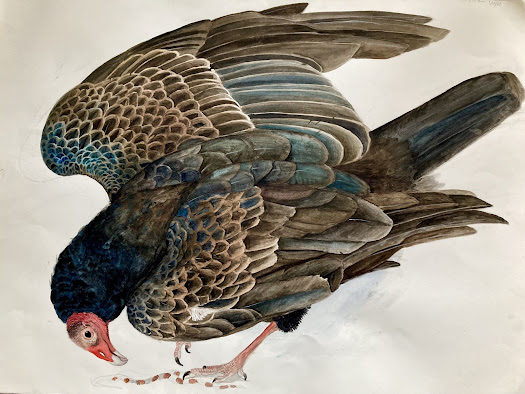A Tale of Two Statues
Recently, during a lovely trip to the National Gallery of Art in Washington DC, I drew studies of two marble statues that really left me thinking. Both statues were of women and both seemed to have something to say about femininity. The first was eye catching to begin with. A statue of a Greek slave girl, carved in 1846 by an American artist, Powers. She (the statue) stood in front of a window, at the end of a room, and with a bench conveniently placed in front of her (perfect for drawing!). The slave girl looked remarkably unconcerned with being in chains. And I found the statue to be in a way, a bit sensational. Almost emotionally manipulative. The slave girl is stands in a very basic and simple pose, with her head slightly turned so that you can appreciate the profile of her face. Her body is very smooth so that all of the shadows fade gently and her arms and wrists are very slender. Her chest is completely uncovered as her arms are both hanging down in chains, although not even very heavy ones. As a whole she seems to be an idealized woman; slender, young, and quiet. The viewer will feel upset that such a perfect looking young woman is bound up in chains.
 |
| The Slave Girl statue (public domain photo from the National Gallery ) |
Overall, the statue tells the viewer exactly what to think, and in my opinion somewhat objectifies the girl depicted.
In the room before the one containing the slave girl statue, was another much smaller statue which I admittedly walked right by on my way to go paint the beautiful slave girl. This one is Eve (carved by artist Rodin in 1890). It is a very small statue and it depicts Eve of the Creation story after she is banished from the Garden of Eden. It’s already a bit striking to see a depiction of this scene without Eve’s companion Adam. But my complicated reactions definitely didn’t end there. The shadows on Eve are harsh and striking. She has the opposite of the flowing and delicate lines of the slave girl. And while the slave girl stands more or less unconcerned, or at least accepting of her fate, Eve grips her own body in grief and despair. She has her shoulders hunched over and her face tucked away and hard to see. Most interestingly to me, was that Eve had a different sort of idealized body; despite her frightened and vulnerable looking pose, she is incredibly muscular and has broad, almost masculine shoulders. You can tell that she’s fallen by seeing how she is uncomfortable and ashamed of her strong and beautiful body. Physically, she represents a different female ideal; health and strength. All people should be physically fit and strong, and here, Eve still appears so as if the consequences of her sin haven’t fully affected her physical state. It makes the viewer uncomfortable to see her so ashamed of her physical state. Eve, is facing spiritual and physical challenges on a much more profound scale than the slave girl. While the slave girl’s emotions appear simple, Eve’s are so much heavier and more complex.
 |
| Image of Eve, taken by me |
In the end, some of my many reactions to these statues are as follows; that the slave girl is a flawed idea of a beautiful woman. She is submissive and seems to have just accepted her horrible fate, rather than trying to change it. One might argue otherwise, but her “ideal” is more sexual than anything else. Especially when seeing her appearance. And again, as a piece of art, she makes the viewer sorry for her in less than ideal ways.
Eve on the other hand, inspires complicated and meditative thoughts as well as feelings. My reaction to the statue was as complicated as all the sharp and contorted lines that made up the statue. Eve represents harsh realities (both physical and spiritual) and makes us consider the loss that other Original Sin caused. She also represents the uncomfortable and unhappy realities of being female. To me, I think Eve properly captures a very real and hard to describe experience of femininity. I’m still left thinking about the statue.
 |
| My very imperfect sketch of Eve, done in liquid graphite and pencil. |

Comments
Post a Comment